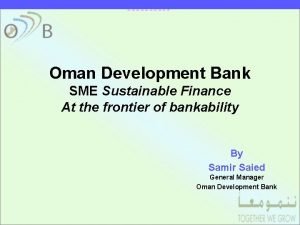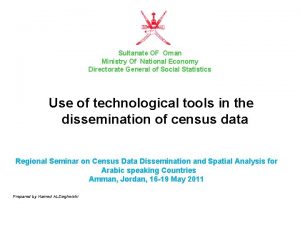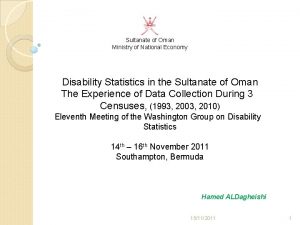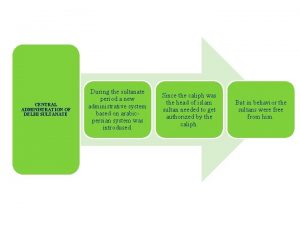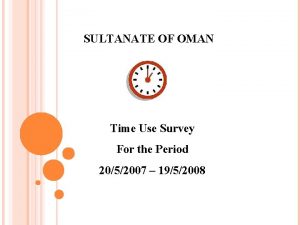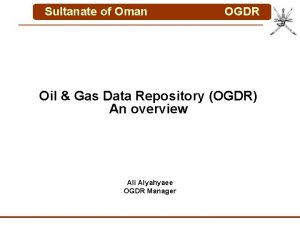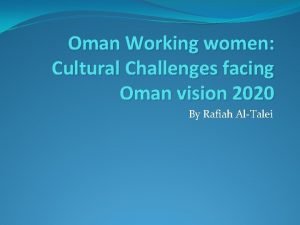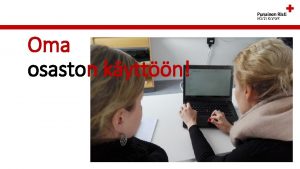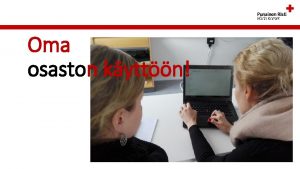SULTANATE OF OMAN MINISTRY OF NATIONAL ECONOMY COGNITIVE




























- Slides: 28

SULTANATE OF OMAN MINISTRY OF NATIONAL ECONOMY COGNITIVE TESTING OF THE WG EXTENDED SET OF QUESTIONS IN OMAN Sawsan Al-lawatia

COUNTRY PROFILE (2010) TOTAL POPULATION: 2, 770, 329 Omanis Expatriates 1, 954, 199 (70. 6%) 816, 130 (29. 4%) Male: 988, 962 (50. 6%) Female: 965, 237 (49. 4%) Male: 621, 778 (76. 2%) Female: 194, 352 (23. 8%)

INTRODUCTION: Based on the importance of participation in international efforts for developing a unique questionnaire for measuring disability through household surveys, the Directorate General of Social Statistics in the Ministry of National Economy (Mo. NE) decided to test the WG’s extended set of questions in Oman in October 2010.

INTRODUCTION: A team of 6 persons was formed representing the main ministries producing statistics about disabled people in the country. They are: Ministry of National Economy, Ministry of Health, Ministry of Education and Ministry of Social Development. All the members of the team held at least a bachelor’s degree either in statistics or in social sciences.

PREPARATION FOR THE FIELD WORK: A workshop was conducted during (4 -6) October 2010 for the team and other participants from some of the Arab countries with cooperation from WG and AITRS. The main objective of the workshop was to train the participants in Cognitive Interview Methodology & Testing Disability Questions. The questionnaire was translated in Arabic and reviewed. It was tested in

CHARACTERISTICS OF THE SAMPLE: The cognitive test was conducted during (16 -20) October 2010 on a selected sample of 33 people. The majority of the sample was selected from some of the educational & rehabilitation institutes in Muscat Governorate such as (Sultan Qaboos University, Omar bin Al Khattab Institute for the Blind, Disabled Rehabilitation Center in Al-Khoud & Creative Center for Rehabilitation). The respondents were 17 males and 16 females. Four of them were youths with Down syndrome (16/17 years of age).

CONTINUED The age distribution of the respondents was as follow: Age Groups Males Females Total No. % (15 -19) 3 17. 6 1 6. 3 4 12. 1 (20 -24) 5 29. 4 4 25. 0 9 27. 3 (25 -29) 5 29. 4 5 31. 3 10 30. 3 (30 -34) 3 17. 6 4 25. 0 7 21. 2 (35 -39) 1 5. 9 0 0 1 3. 0 (65 -69) 0 0 1 6. 3 1 3. 0 Not stated 0 0 1 6. 3 1 3. 0 Total 17 100 16 100 33 100

MAIN FINDINGS: ANSWERS TO THE SHORT SET QUESTIONS Field No Difficulty Some Difficulty Lots of Difficulty Cannot Do at All Total Vision 24 3 0 6 33 Hearing 31 0 0 0 31 Mobility 14 7 3 5 29 Communication 18 8 1 Cognition 8 17 3 0 28 Self-Care 25 2 1 0 28 One of them was complaining about the sunglasses and not his vision 27

COMMENTS ABOUT VISION: 1. According to the respondents, type of response to the amount of difficulty in seeing someone’s face across the room depends on the size of the room as well as the amount of light. Therefore, the question needs to be standardized. Difficulty seeing, even Difficulty in seeing someone’s face across the room when wearing glasses 2. No difficulty Some difficulty lot of difficulty No difficulty 80. 8% 7. 7% 0 Some difficulty 3. 8% Total 22 3 1 Some of the respondents couldn’t understand the Arabic translation for the phrase seeing far away (5 out of 27). One of the respondents had autism.

COMMENTS ABOUT HEARING DOMAIN: 1. Although one of the female respondents was using a hearing aid all the time, and another lady could not hear with her right ear no one reported having difficulty in hearing!! 2. A sign language translator was assisting the interviewer with the lady using a hearing aid, and according to her it is difficult to translate the question as they are written, there should be a modified version for those using sign language in Arabic countries.

COMMENTS ABOUT HEARING DOMAIN: 3. Questions H-S 2 and H-S 3 were not translated correctly. The Arabic translation involved: hearing a conversation between two persons in a quite room or in a noisy room! This explains why people related their responses to the need for concentration in their stories. Some of the factors mentioned in the stories were: The speed of the conversation, the distance from the conversation, the level of the noise in the room and the language of the conversation. Only the lady having problem in her right ear mentioned her position to the conversation.

COMMENTS ABOUT MOBILITY DOMAIN: Some of the answers to having difficulty walking or climbing stairs were for reasons other than using lower part of body. Some of the stories are: 1. A female respondent using a hearing aid all the timed said she is having a lot of difficulty in walking or climbing stairs because she is feeling unbalance most of the time. 2. Another reason for some other respondents was being blind and cannot walk or climb stairs in unfamiliar places. 3. A lady said she has some difficulty because she is afraid of high places, she has acrophobia.

MOBILITY: CONTINUED MOB_1: Do you have difficulty moving around inside your home? 5 respondents reported cannot do at all, while the other 24 had no difficulties. Going back to their stories it was found that the 3 people who said they couldn’t move in their homes were able to move, but the environment is not suitable. 1 • A blind lady who could not walk in her backyard. But can easily move around inside her house. 2 • A person who uses his arms and hands for moving around inside his home, but said his house his not prepared for him. 3 • A lady who can move around in her ground floor using her arms and hands, but can not go to the first floor of the house.

MOBILITY: CONTINUED MOB_2 Do you use any equipment or receive help for getting around? Out of the 15 who had reported in MOB_SS having some sort of difficulty, 13 are using an equipment or receive help in moving around. Type of equipment No. Cane or walking stick 1 Walker or Zimmer frame 0 Crutches 2 Wheelchair 7 Artificial limb (leg/foot) 1 Someone’s assistance 2 Total 13 The walking stick is used by a blind lady to move around. A blind person also needs assistance in moving around specially in new places.

MOBILITY: CONTINUED Mobility without using the aids: Distance No difficulty Some difficulty A lot of difficulty Can not do at Total all 100 m 18 0 0 4 22 500 m 15 2 1 2 20 Only four ladies did not recognize the distance of 100 meters and the question was repeated and explained more for them. Obviously there is a conflict between the answers marked in red. Longer distances should be of more problematic for disabled than shorter distances!!

MOBILITY: CONTINUED MOB_6: Do you have difficulty walking up or down 12 steps [without the use of your aid]? Respondents thought about the shape of the stairs and the existence of a stair case. Mobility with the use of aids: Distance No difficulty Some difficulty A lot of difficulty Can not do at Total all 100 m 6 0 0 0 6 500 m 4 2 0 0 6 12 steps 4 2 0 0 6

MOBILITY: CONTINUED The relation between climbing stairs without and with using an aid: Without an aid Level of difficulty with an aid No difficulty 3 Some difficulty 1 Some A lot Cannot do at all Total Skipped 4 1 A lot of diff. 0 Cannot do at all 2 2 Skipped Total 7 4 2 0 All of them are blind people and their answers for without aid were for to using stairs in familiar place. One of them uses a walking stick, and the other two needs someone’s assistance. 0 2 2 6 12 Both of them use crutches. One of them changed his answer in the 2 nd round to a lot of difficulty with his aid.

MOBILITY: CONTINUED The main problem with this domain was the amount of questions that required longer time compared to other domains. Some of the respondents suggested changing the questions of climbing the stairs to stepping down the stairs because it is much easier than climbing, even when using, for example, crutches.

UNFORTUNATELY THE WORD (NERVOUS) WAS TRANSLATED TO ANGRINESS AND THE TEAM WAS NOT AWARE OF THE TRANSLATION PROBLEM BECAUSE ANGRINESS IS MENTIONED IN THE (ICF). BOTH ANXIETY AND ANGRINESS WERE MENTIONED IN THE ARABIC TRANSLATION OF THE QUESTION REGARDLESS OF BEING DIFFERENT FEELINGS. MANY OF THE RESPONSES IN THIS QUESTION WERE FOR ANGRINESS AND NOT ANXIETY Never Daily Few Times in a year Monthly Weekly

DEPRESSION Field Depression Daily 3 Weekly 4 Monthly 5 Few times a year 8 Never 7 Total 27 Although 74% of respondents had some sort of frequent depression, none of them was on any medication for that. All of them suggested avoiding this question in future because being depressed is normal. According to them it’s one of the daily feelings one gets.

CONT. DEPRESSION The main reasons for getting depressed were: personal and family problems (26%), health status(7. 4%) , worried about the results of the exams (3. 7%), Thinking about the future (3. 7%) and being bored (3. 7%). (44%) did not respond. In reference to the last time any of the respondents felt depressed, 24% said they were depressed a lot and around 47% said it was somewhere between a little and a lot. 56% of those said that the depression was exactly in the middle.

PAIN (X): Do you have frequent pain? Yes No Total 8 19 27 In the past 3 months, how often did you have pain? Main reasons for getting frequent pain were: Illness (73%), Work load (20%) and sports (7%) Comparing the answers of the respondents to their stories shows: Summary Story doesn’t match the response category 2 Changing the response category 2 The respondent did not understand the question 1

PAIN CONT (X): Duration of the pain: Severity of the last pain: A little A Lot Between a little and a lot 9 7 5 Data shows some relation between feeling pain and difficulty in mobility: Frequent Pain Do you have difficulty walking or climbing steps? Never Some difficulty A lot of Difficulty Cannot do at all Yes 0 2 2 3 No 13 5 0 1

FATIGUE Field Daily Most days Some days Never Total Fatigue 1 (4%) 3 (12%) 20 (80%) 1 (4%) 25 (100%) The main reasons for feeling tired or exhausted were: Work load (15%), Lack of sleep (25%), both previous reasons (15%), Studying (10%), illness (20%), unusual activities such as walking long distances (15%). Summary of the stories No. Answer doesn’t match the story 2 Changing the answer 1 Did not understand the question 1 The respondent who changed his answer is complaining about the work load and he said his body is not tired but his mind.

COMMENTS ABOUT THE INTERVIEWS WITH DOWN SYNDROME YOUTH: None of the respondents answered any question as written. All questions were asked in a very simple language trying to be as friendly as possible. None of the Down syndrome respondents could report his/ her age. One of them answered no difficulty to the Vision short question, and that his glasses were at home!!. Later his teacher explained that previously he wore glasses but couldn't concentrate on anything else than his glasses. Therefore his teachers suggested that he should not wear them at school this year. Another person’s response for seeing someone across the room was an indication with her head (as yes) for seeing me, her teacher in the class and other stuff in the interview room. But it's not certain that she did really understood the phrase (across the room).

LESSONS LEARNED: The work team was not really qualified to deal with people with Down syndrome. In fact, some of the interviewers were not able even to deal with people with disabilities. They were very emotional during the interviews. This implies that special training should be given to disability data collectors. After translation to any language other then English, the questions should be reviewed with WG experts to avoid any misunderstandings or translation errors. The written Arabic language is different than the spoken language not only in many parts of the Arabic world, but also inside the country. Therefore, more cognition tests should be done in the Arabic world in order to have a well translated and standardized version of the questionnaire.

LESSONS LEARNED: CONTINUED Proxy was used in some of the interviews with those having mental disorders and those using sign language. The field test shows that the responses are influenced by the proxy’s responses and understandings. Therefore, the interpretation of those responses should be done very carefully. There is a shortage in Arabic speaking experts in the field of Disability statistics. Many of those who are producing disability statistics are still dealing with the handicap concept regardless of the new terminology that is being used.

THANKS FOR YOUR ATTENTION
 Ministry of national economy oman
Ministry of national economy oman National centre for statistics and information oman
National centre for statistics and information oman Cognitive and non cognitive religious language
Cognitive and non cognitive religious language Cognitive economy psychology definition
Cognitive economy psychology definition Athenian economy vs sparta economy
Athenian economy vs sparta economy Slave khilji tughlaq lodi dynasty
Slave khilji tughlaq lodi dynasty Delhi sultanate ap world history
Delhi sultanate ap world history Administration of bahmani kingdom
Administration of bahmani kingdom Chapter 15
Chapter 15 Tughlaq dynasty
Tughlaq dynasty Ministry of education morocco
Ministry of education morocco Ministry of national education romania
Ministry of national education romania Ministry of national development planning indonesia
Ministry of national development planning indonesia Summer internship project report on marketing strategy
Summer internship project report on marketing strategy Ras sticker oman
Ras sticker oman Planine srbije kviz
Planine srbije kviz Sustainable finance
Sustainable finance Oman chemicals
Oman chemicals Oaaa oman
Oaaa oman Virtual reality company in oman
Virtual reality company in oman Lakbi oman
Lakbi oman Nizw
Nizw Omanxxxxxx
Omanxxxxxx Oman mobile number digits
Oman mobile number digits Oman cartina
Oman cartina Sme development fund oman
Sme development fund oman Central java map
Central java map Oman relative location
Oman relative location Mateja oman
Mateja oman
















